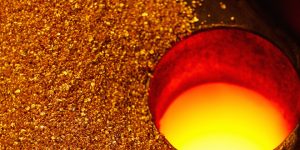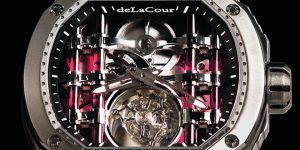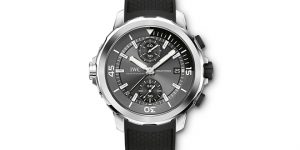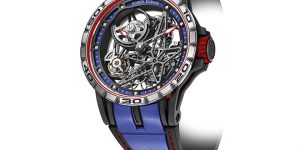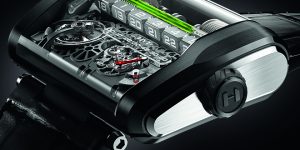Luxury watchmakers from Switzerland: Interview with Co-President of Chopard, Karl-Friedrich Scheufele, on the essence of watchmaking
Karl-Friedrich Scheufele has spent the past 20 years developing Chopard’s manufacturing capabilities, and the brand has much to leverage on thanks to this

The watch that started it all — Chopard’s L.U.C 1860.
It is almost too easy to be envious of Karl-Friedrich Scheufele. As one of Chopard’s two co-presidents alongside his sister Caroline, he manages a group that’s vertically integrated to the extent of virtual self-sufficiency, while being wholly family owned and free from any shareholder influence or pressure. Thus, he has the freedom and ability to pursue his interests, and the man is very specific about what he likes.
Chopard’s Classic Racing collection, for instance, was borne out of Scheufele’s love for classic cars and their associated races, some of which he participates in personally. The brand’s involvement in this universe extends to sponsorships for specific events, as well as the Porsche Motorsport team. Ferdinand Berthoud is another example, as the latest addition to the Chopard group, it began as a passion project and only debuted its first watch, a time-only chronometer with a tourbillon escapement, in 2015. In many ways, Scheufele is a holdover from an earlier era when owners, guided by their personal interests, had a direct hand in — and heavy influence on — the activities of their companies. With Chopard entering its third decade of reestablishment as a manufacture, this does not look set to change, and the brand is all the better for it.

Karl-Friedrich Scheufele, Co-President of the Chopard Group and President of la Chronométrie Ferdinand Berthoud.
It is the 20th anniversary of Chopard’s manufacture. Looking back, what were some of its biggest milestones?
The first was of course 1996, when we began to re-establish the manufacture and reacquire the knowledge and know-how of producing watch movements in-house. That really developed the commercial possibilities for the group, and we started to be recognised as a serious watchmaker again. We presented our integrated chronograph 10 years later, so that was another milestone. We unveiled the L.U.C Full Strike, our first minute repeater, this year, and this was another highlight because with it, we have more or less covered the full spectrum of complications. It is almost like we’ve cleared the tests that a manufacture needs to pass in order to be recognised as one.
Was there any single factor that drove your decision to re-establish the manufacture?
It was all about credibility in the beginning — to be recognised as a manufacture. Later on, independence became as important a consideration, which prompted me to work on vertical integration.
The point about credibility is an interesting one, because the term “in-house” has become somewhat diluted in recent years.
Oh yes, I agree. The French term “manufacture” has been diluted a lot, because it is used too easily nowadays, although we really do live the part. There are many brands that claim to but don’t, because it is a bandwagon that everybody wants to get on.

L.U.C Chrono One, Chopard’s first in-house integrated chronograph.
What do you consider necessary for a brand to possess, before it can call itself a manufacture?
It is about mastering the different stages of production, from conceptualising a calibre, to prototyping, to the production of essential movement parts such as baseplates and hairsprings. Then, there is assembly, and quality control. In my opinion, a brand’s movements must also reach certain levels of precision and finissage quality. We’ve started reacquiring this capability in 1996, and finally declared ourselves fully integrated in 2006.
This organic growth took you a very long time, compared to brands that chose to acquire assets like production facilities and watchmakers.
Yes. Our choice was to start with a blank slate, partly because there wasn’t anything suitable for us to acquire then. Maybe it is also because I prefer to take the harder route.
You highlighted the integrated chronograph as one of Chopard’s milestones. Several other brands that we’ve spoken to also consider their integrated chronographs to be significant, instead of a high complication like a perpetual calendar, or even a tourbillon. Why?
With the tourbillon, for example, the real complexity is limited to just the parts that are linked to the tourbillon mechanism, while the rest of the movement is relatively easier to design. An integrated chronograph has many parts interacting with each other — the moment you actuate the pusher, you start off a chain of events that affect various parts of the movement. Because there is so much to consider, and because everything has to be adjusted to work together and run smoothly, it is more indicative of a manufacture’s capabilities.

L.U.C Full Strike, released to mark the 20th anniversary of the manufacture’s re-establishment.
Has Chopard crossed the finishing line with its release of the L.U.C Full Strike?
Oh no, there are many different areas that we want to explore, including high frequency movements and complications. There is also general R&D work to improve our watches’ precision, service intervals, and even aftersales service.
How did the idea to use crystal gongs in the L.U.C Full Strike come about?
It is like every L.U.C watch that we’ve presented so far. In our first L.U.C movement, for example, we didn’t just want a calibre with a micro-rotor — it needed to have additional value, which took the form of bidirectional winding and a stacked, two-barrel configuration. Every other L.U.C movement also offers a little extra bit of innovation. For the minute repeater, we worked on adding to what has already been achieved so far. The idea was to make a minute repeater that can be shared — if a group is sitting around a table, everyone should be able to hear it. At the same time, it must have a good sound; I’m an audiophile, and I wanted the minute repeater to be like a good Hi-Fi system that offers the same playback quality independent of its volume. We settled on the idea of using sapphire crystal as the sound had to escape from somewhere, and it is the watch crystal anyway. What had previously been done was to connect the crystal to the gongs, but there was never an integrated system. The challenge for us was to construct the gongs and crystal as a single structure.

Chopard Manufacture, Fleurier
It looks like you’re still very personally involved in the watches’ developments.
Let’s put it this way, if I could delegate everything else and just do what I want to, this is precisely it.
The industry has many standards now, from COSC to region-specific ones like Poinçon de Genève, to in-house ones like Superlative Chronometer. Do you think the watch industry will benefit from having a single overarching standard?
It will probably benefit consumers, because a single standard is easier to understand. I don’t think this will happen though, because the industry’s players like to develop their own standards. Some companies want to do it in-house, because they can. That’s fine, but if you look at bookkeeping, the practice is to have external auditors. Similarly, I prefer third-party certification such as COSC, because we cannot influence anything, so it is the most objective way to judge if our movements are performing well. In any case, there is no right or wrong answer — it is a philosophical question.
What about minute repeaters? Should a standard be developed for it?
I think this is one of the few areas of watchmaking that really comes down to preference. Acoustics and the perception of sound are very personal matters.

Watches undergoing Chronofiable testing, as part of Qualité Fleurier’s certification procedures.
But surely some aspects can be quantified, such as the cadence, or the gap between the hours and the minutes should there be no quarters to strike.
Our idea was to have a short gap, but I’ve heard from someone who prefers to have a longer period of silence. At the end of the day, there will be some who prefer our minute repeater’s chimes, and others who will prefer another brand’s. You can tell me that you prefer Chateau Haut-Brion 1961 to Romanee-Conti 1995. I will say both are top quality wines — it is just that you prefer Bordeaux, while I prefer Burgundy.
Who, then, was the final arbiter of how the chimes of the L.U.C Full Strike would sound?
It was a group decision. Minute repeaters are rare animals, so we didn’t have the chance to listen to every possible one before starting the project. However, as the project progressed, I was able to listen to more examples of them in the course of my travels. Thankfully, these opportunities only reassured me that our project was on the right track.
Why did you start Ferdinand Berthoud as a new brand instead of just integrating it as a new collection under Chopard?
I think that Chopard already has so many facets, and it is difficult to communicate them all. In fact, rather than adding a new collection, Chopard ought to focus on just a few of its existing ones. We didn’t go out there with the intention of adding another brand to the group anyway. It was almost a coincidence that I came across the Berthoud name and learned about his work. Here was an opportunity with a really interesting watchmaker whose work was worth reviving, and it led to a passion project. This was why I started Ferdinand Berthoud, not because we were looking for a reason to increase sales.

A pocket watch originally made by Ferdinand Berthoud.
With Ferdinand Berthoud, you don’t seem concerned with releasing novelties every year.
Well, I completely disapprove of the recent race to present novelties continuously, because serious watch collectors just cannot follow this tempo any more. We’re not in the fashion industry, and do not have the same approach.
What kind of pace would you like to see then?
I’d like to see a more organic, natural cadence, where brands launch new products when they are genuinely ready to. In recent years, I’ve been getting the feeling that products are being launched too early, before they are fully developed, just to satisfy the need for communication, or for the brand to be talked about and remain visible. It just isn’t in the long-term interest of the brand or industry.
In a way, this has been the result of shorter attention spans.
Yes, that is true, but put yourself in the shoes of a potential Ferdinand Berthoud buyer who’s considering whether to spend such a large sum of money. If he does, and if we were to launch the FB 2 next year, he may think, “Oh, I should have waited.” It becomes very difficult to make a decision in such circumstances. The last new Porsche that I bought was the 1997 model of the 911, because it was the final one with an air-cooled engine, and the last 911 that corresponds to exactly what I think that car is all about. Of course, there are people who will buy the latest Ferrari every few years and get rid of the previous one, but I’m not that type of person. It is a different type of buying behaviour, and I think that the Ferdinand Berthoud client is someone who will consider his acquisitions seriously like I do, and we should afford him the time to do so.

Ferdinand Berthoud Chronomètre FB 1, which draws its movement and design elements from marine chronometers of yore.
Unfortunately, companies do have shareholders to answer to, which leads to such a pace of product development and release.
But that is, unfortunately, not necessarily compatible with the essence of watchmaking.
This article was originally published in WOW #43 (Festive 2016) issue.





